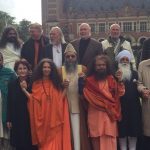On the day of Eid the entire Muslim community congregates in observance of the Eid Prayer. It can be prayed any time after sunrise until noon and must be done so in congregation.
The Eid Prayer is similar to the Friday Prayer in its number of cycles (two), in that it is recited out loud, and that both have sermons. However, unlike the Friday Prayer, the Eid Prayer’s sermon follows the prayer.
The second difference lies in its number of Takbirs (when the prayer leader says, “God is the Greatest” which starts the prayer). In the Eid Prayer there are six additional Takbirs added to the original in the prayer’s first cycle, and five added to the second cycle of prayer (after one rises from the sitting position to stand for the second cycle).
It is also the practice of the Prophet (peace be upon him) to read, after the first chapter of Qur’an, the 87th chapter in the first cycle of prayer and the 88th in the second cycle. Others considered it commendable to recite the 50th chapter from the Qur’an in the first cycle and the 54th in the second. However, if one is unable to read those chapters, there is nothing wrong with reading whatever he knows from the Qur’an.
Eid Prayer is a highly encouraged act for those ordered to pray the Friday Prayer and recommended for those who are not obligated to pray the Friday prayer, according to a group of scholars. However, there are other great scholars who hold it to be a religious obligation.
Things to do –
To keep night vigil the night before the `Eid Prayers.
To take a ritual bath prior to the prayer.
To apply perfume (for men only).
To wear one’s best clothing.
To return from the prayer using a different route.
To eat something before the Eid Prayer.
To set out for the Masjid early engaging in Takbir.
To pray in an open space.
One should not pray before or after the Eid Prayer.









